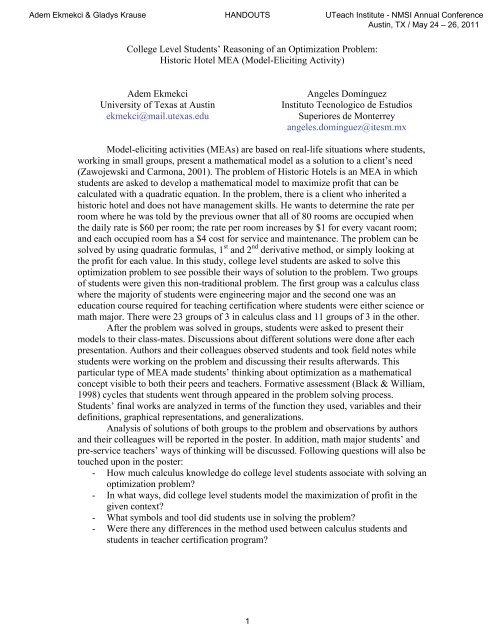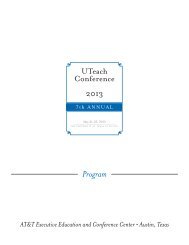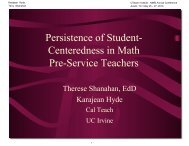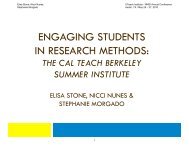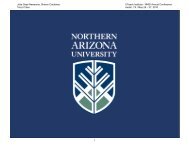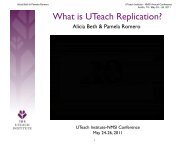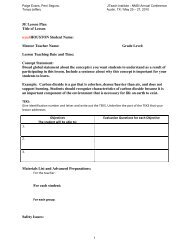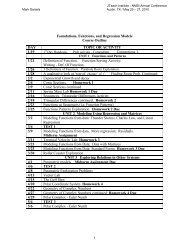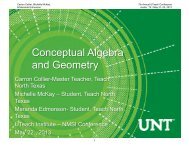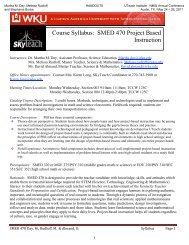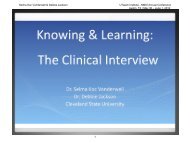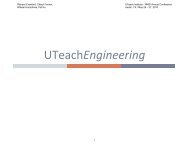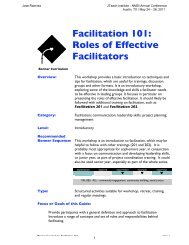Model-Eliciting Activities (MEAs) - The UTeach Institute
Model-Eliciting Activities (MEAs) - The UTeach Institute
Model-Eliciting Activities (MEAs) - The UTeach Institute
You also want an ePaper? Increase the reach of your titles
YUMPU automatically turns print PDFs into web optimized ePapers that Google loves.
Adem Ekmekci & Gladys Krause HANDOUTS <strong>UTeach</strong> <strong>Institute</strong> - NMSI Annual Conference<br />
Austin, TX / May 24 – 26, 2011<br />
College Level Students’ Reasoning of an Optimization Problem:<br />
Historic Hotel MEA (<strong>Model</strong>-<strong>Eliciting</strong> Activity)<br />
Adem Ekmekci<br />
University of Texas at Austin<br />
ekmekci@mail.utexas.edu<br />
Angeles Domínguez<br />
Instituto Tecnologico de Estudios<br />
Superiores de Monterrey<br />
angeles.dominguez@itesm.mx<br />
<strong>Model</strong>-eliciting activities (<strong>MEAs</strong>) are based on real-life situations where students,<br />
working in small groups, present a mathematical model as a solution to a client’s need<br />
(Zawojewski and Carmona, 2001). <strong>The</strong> problem of Historic Hotels is an MEA in which<br />
students are asked to develop a mathematical model to maximize profit that can be<br />
calculated with a quadratic equation. In the problem, there is a client who inherited a<br />
historic hotel and does not have management skills. He wants to determine the rate per<br />
room where he was told by the previous owner that all of 80 rooms are occupied when<br />
the daily rate is $60 per room; the rate per room increases by $1 for every vacant room;<br />
and each occupied room has a $4 cost for service and maintenance. <strong>The</strong> problem can be<br />
solved by using quadratic formulas, 1 st and 2 nd derivative method, or simply looking at<br />
the profit for each value. In this study, college level students are asked to solve this<br />
optimization problem to see possible their ways of solution to the problem. Two groups<br />
of students were given this non-traditional problem. <strong>The</strong> first group was a calculus class<br />
where the majority of students were engineering major and the second one was an<br />
education course required for teaching certification where students were either science or<br />
math major. <strong>The</strong>re were 23 groups of 3 in calculus class and 11 groups of 3 in the other.<br />
After the problem was solved in groups, students were asked to present their<br />
models to their class-mates. Discussions about different solutions were done after each<br />
presentation. Authors and their colleagues observed students and took field notes while<br />
students were working on the problem and discussing their results afterwards. This<br />
particular type of MEA made students’ thinking about optimization as a mathematical<br />
concept visible to both their peers and teachers. Formative assessment (Black & William,<br />
1998) cycles that students went through appeared in the problem solving process.<br />
Students’ final works are analyzed in terms of the function they used, variables and their<br />
definitions, graphical representations, and generalizations.<br />
Analysis of solutions of both groups to the problem and observations by authors<br />
and their colleagues will be reported in the poster. In addition, math major students’ and<br />
pre-service teachers’ ways of thinking will be discussed. Following questions will also be<br />
touched upon in the poster:<br />
- How much calculus knowledge do college level students associate with solving an<br />
optimization problem?<br />
- In what ways, did college level students model the maximization of profit in the<br />
given context?<br />
- What symbols and tool did students use in solving the problem?<br />
- Were there any differences in the method used between calculus students and<br />
students in teacher certification program?<br />
1


